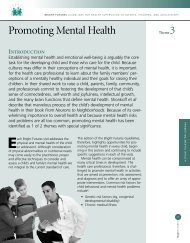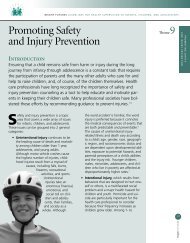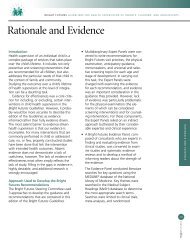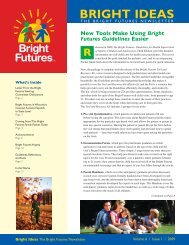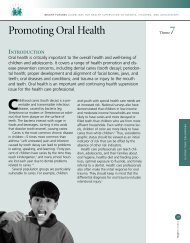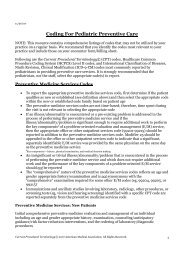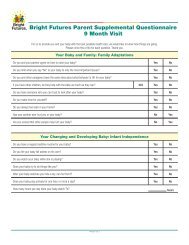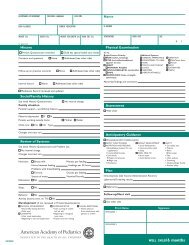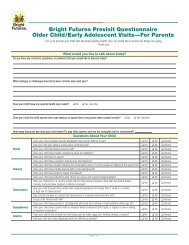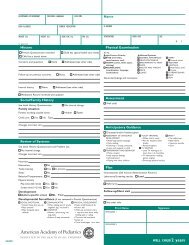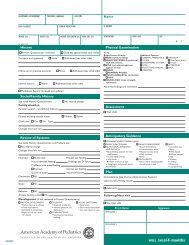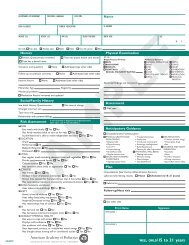POCKET GUIDE - Bright Futures - American Academy of Pediatrics
POCKET GUIDE - Bright Futures - American Academy of Pediatrics
POCKET GUIDE - Bright Futures - American Academy of Pediatrics
Create successful ePaper yourself
Turn your PDF publications into a flip-book with our unique Google optimized e-Paper software.
15 monThs<br />
Interview Questions<br />
■ Are you breastfeeding your child? Are you giving her<br />
bottles? Milk in a cup? What kind <strong>of</strong> milk does she drink?<br />
how much?<br />
■ how much fruit juice or how many sweetened drinks<br />
(fruit drinks, s<strong>of</strong>t drinks) does your child drink? is the<br />
juice 100% fruit juice? When does she drink them?<br />
■ Which foods does your child like to eat? Are there any<br />
foods she doesn’t like?<br />
■ Describe your child’s mealtimes. Does she eat with<br />
the family?<br />
■ Does she ask for food between meals and snacks?<br />
if so, how do you handle this?<br />
■ Does your child throw tantrums over food? if so,<br />
how do you handle them?<br />
■ What kinds <strong>of</strong> physical activities does your child enjoy?<br />
■ What concerns do you have about your child’s weight?<br />
Screening and Assessment<br />
■ evaluate the child’s progress in developing large motor<br />
skills. Children should be actively playing with a<br />
parent daily.<br />
Anticipatory Guidance<br />
discuss with Parents<br />
■ <strong>of</strong>fering their child food every 2 to 3 hours. (Children’s<br />
capacity to eat at any one time is limited.)<br />
■ giving their child opportunities to develop eating skills<br />
(chewing, swallowing) by <strong>of</strong>fering a variety <strong>of</strong> foods and<br />
eating at a family table.<br />
■ <strong>of</strong>fering age-appropriate foods (cut food into small<br />
pieces) and continuing to monitor the size <strong>of</strong> foods.<br />
(Chewing and swallowing functions are not completely<br />
developed until about age 8.)<br />
■ Making eating easier for their child by using spoons,<br />
cups, and dishes with steep sides (bowls).<br />
■ Being patient as their child’s skill at eating a variety <strong>of</strong><br />
foods increases.<br />
■ Providing a relaxed atmosphere during meals and<br />
snacks. (Children should not be rushed, because trying<br />
new foods takes time.)<br />
■ Discouraging television viewing and encouraging<br />
interactive activities (talking, playing, singing, and<br />
reading together).<br />
33<br />
<strong>Bright</strong> FUTURES<br />
Early Childhood



